
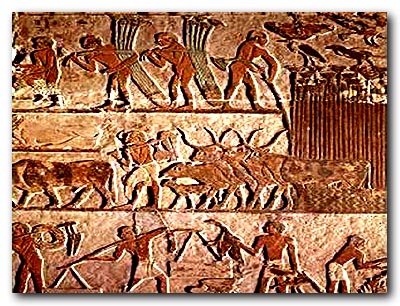 |
| Civilization in the Ancient Indus River Valley |
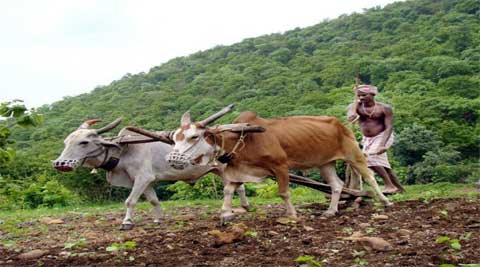


Agriculture and the tillers of the soil are the linch-pin of the revolving world (உழுவார் உலகத்தார்க்கு ஆணி). Agriculture was the main vocation of Sangam Tamils and necessity of their life. Therefore they bestowed maximum attention upon agriculture. Tirukural devotes an entire chapter on agriculture (ref. couplets 1031 - 1040). Tiruvalluvar extols the glory and greatness of agriculture and farmers:
சுழன்றும்ஏர்ப் பின்னது உலகம் அதனால்
உழந்தும் உழவே தலை. (Tirukural 1031)
Agriculture, though laborious, is the most excellent (form of labour); for people, though they go about (in search of various employments), have at last to resort to the farmer
உழுதுண்டு வாழ்வாரே வாழ்வார் மற்றெல்லாம்
தொழுதுண்டு பின் செல்லுவார். (Tirukural 1033)
They alone live who live by agriculture; all others lead a cringing, dependent life.
Cultivation of the food crops would have started in the 'Neostone age.' Archaeological evidences confirm that earliest cultivation in ancient Tamilakam would have started in the last phase of the 'Neostone age.' The farmers of this age cultivated crops such as rice, millets, various grams, beans, tamarind, sugarcane, plantain, coconuts, pepper, cotton, and sandalwood. Sangam literature has references about use of iron agricultural tools and the farmlands were supported by water bodies such as tanks, wells and irrigation canals.
We have already noted about the existence of five geographical divisions of the Tamil country in Sangam literature i.e., Vanpulam or hardland (Mullai and Kurinji), Menpulam or fertile land (Marutam), Pinpulam or dry land (Mullai, Palai) and Kalarnilam or Uvarnilam or Salty land (Neital). The kinds of soil known during Sangam age included the alluvial soil, red soil, black soil, laterite soil and sandy soil and they knew what crops could be grown on each type of soil. Sangam literature has abundant references about agriculture. Purananuru, Perumpanatruppadai, Porunaratruppadai, Pattinappalai and Mathuraikanchi lines are shown here to depict the prosperity of Sangam era Tamilakam.
ஏர் பரந்த வயல் நீர் பரந்த செறுவின்நெல் மலிந்த மனைப் பொன் மலிந்த மறுகின்
Purananuru 338, Poet: Kundrur Kilar Makanar,
Like Ponthai city of Neduvel Athan, with wide, plowed watery fields, houses filled with rice paddy, streets with gold, and groves with bees buzzing many flowers, she has great wealth.
தட்டோர் அம்ம இவண் தட்டோரே
தள்ளாதோர் இவண் தள்ளாதோரே.
Purananuru 18, Poet Kudapulaviyanar sang to Pandiyan Thalaiyalankanathu Cheruvendra Neduncheliyan,
O Cheliyan of murderous battles! You should not disdain my advice, but act quickly! Those who harnessed the flowing waters and built dams on land with depressions have established their glory! Those who have built none will have no enduring fame in this world! Civilization in the Ancient Indus River Valley
Pattinappalai depicts the king's intention to destroy forests and convert them into paddy fields.
காடு கொன்று நாடாக்கிக்
குளம் தொட்டு வளம் பெருக்கிப்
(Pattinappalai 283 -84)
The King Cholan Karikalan who Brought Prosperity to his Country: Cholan Karikalan destroyed forests and made them habitable, dug ponds, expanded his capital city of Uranthai
Prosperity of Mathurai as shown Mathuraikanchi:
மழை தொழில் உதவ மாதிரம் கொழுக்க
தொடுப்பின் ஆயிரம் வித்தியது விளைய
நிலனும் மரனும் பயன் எதிர்பு நந்த
(Mathuraikanchi 10 – 12)
Without fault, rains help, the land thrives everywhere, one seed yields thousands, and land and trees give abundant benefits.
நீர்த் தெவ்வும் நிரைத் தொழுவர்
பாடு சிலம்பு இசை ஏற்றத்
தோடு வழங்கும் அகல் ஆம்பியின்
கயன் அகைய வயல் நிறைக்கும்
மென் தொடை வன் கிழாஅர்
அதரி கொள்பவர் பகடு பூண் தெள்மணி
(Mathuraikanchi 89 – 94)
On the seashore filled with sand and sapphire colored mundakam flowers, there are sounds of those singing as they draw water rapidly with their wide buckets to water the fields, along with those
from strong water-lifts with delicately tied strings, as the ponds become dry. There are jingling sounds from the clear bells on bulls that thresh.
வெள்ளம் மாறாது விளையுள் பெருக
நெல்லின் ஓதை அரிநர் கம்பலை
(Mathuraikanchi 109 – 110)
Splendor of Muthu Vellilai town: In your Muthu Vellilai town, the waterflows in your rivers do not change, harvests are abundant, and rustling sounds of grain spears are heard.
நல்லேர் நடந்த நசைசால் விளைவயல்
(Mathuraikanchi 173)
Where fine bulls walked to plow the yielding field
Porunaratruppadai
கூனிக் குயத்தின் வாய் நெல் அரிந்து
சூடு கோடாகப் பிறக்கி நாள் தொறும்
குன்று எனக் குவைஇய குன்றாக் குப்பை
Porunaratruppadai 242 - 48)
Prosperity showered by River Kāviri: Women bend and cut paddy with sickles, and bundles of sheaves are stacked each day like mountains, in heaps that never become small.
Perumpanatruppadai
மிதி உலைக் கொல்லன் முறி கொடிற்று அன்ன
கவைத்தாள் அலவன் அளற்று அளை சிதைய
பைஞ்சாய் கொன்ற மண்படு மருப்பின்
கார் ஏறு பொருத கண்அகன் செறுவின்
உழாஅ நுண் தொளி நிரவிய வினைஞர்
முடிநாறழுத்திய நெடுநீர்ச் செறு
(Perumpanatruppadai 206-212)
Dark colored oxen with sand on their horns from fighting with each other ruin the reeds and the mud holes of crabs with forked legs, resembling broken tongs used by a metalsmith who blows softleather bellows by pressing a treadle with his feet. Workers walk on fine mud and prepare the land without plowing and press down the paddy seedlings in the fields with abundant water
ஒரு பிடி படியுஞ் சீறிடம்
எழு களிறு புரக்கும் நாடு கிழவோயே.
Purananuru 40, Poet Avur Moolankilar sang to Cholan Kulamutrathu Thunjiya Killivalavan,
O lord of the country where a small space fit for a female elephant produces food for seven male elephants!
To remove the poverty of his relatives, the peasant obtained low yielding kodo millet on loan. Purananuru poem 327 portrays the condition of the peasant even during Sangam era.
சில்விளை வரகின் புல்லென் குப்பை
தொடுத்த கடவர்க்குக் கொடுத்த மிச்சில்
பசித்த பாணர் உண்டு கடை தப்பலின்
ஒக்கல் ஒற்கம் சொலியத் தன்னூர்ச்
சிறு புல்லாளர் முகத்தவை கூறி
வரகுடன் இரக்கும் நெடுந்தகை
அரசு வரின் தாங்கும் வல்லாளன்னே.
Purananuru 327, Poet: Unknown,
After giving besieging creditors their due share, the noble man who had the strength to repel kings had a small heap of low-yielding millet, stamped by youngsters, without bulls touching them to thresh, that was eaten up by hungry bards. Since no one came to his gate, in order to remove the poverty of his relatives, he told petty minded men what he needed and borrowed millet from them.
Another Purananuru poem 333 depicts the peasant's suffering due to poverty. They lead a miserable life. In this house the peasant householder has spent all the common millet by serving millet meals to the bards. He don't want to leave his guest with hungry stomach. So the couple decided to cook the clusters of millet preserved as a seed for sowing. The housewife hand pounded the millet and cooked the food and served to the bard.
இரவல் மாக்கள் உணக்கொளத் தீர்ந்தெனக்
குறித்துமாறு எதிர்ப்பை பெறாஅ மையின்
குரல் உணங்கு விதைத் தினை உரல்வாய்ப் பெய்து
சிறிது புறப்பட்டன்றோவிலளே தன்னூர்
Purananuru 333, Poet: Unknown,
O poets, because the housewife, since all her common millet and little millet have been given to those in need, and unable to give anything else, will set the clusters of millets that was set aside for seed on her pounding stone, and feed you, before she lets you go.
Tolkappiyam (தொல்காப்பியம்) is the earliest available grammatical work in Tamil. It is composed in the form of short formulaic compositions a.k.a noorpaa (நூற்பா). Its three books include the Ezhuttadikaram, the Solladikaram and the Poruladikaram. In the third book Poruladikaram (பொருளதிகாரம்), Marapiyal (மரபியல்) chapter, noorpaa (நூற்பா) 623 defines about eight kinds of food:
“மெய் திரி வகையின் எண்வகை உணவில் செய்தியும் உரையார்” (Tolkappiyam, Poruladikaram, Marapiyal, Noorpaa 623)
Ilampooranar ( இளம்பூரணர்), a commentator of Tolkappiyam interprets the eight kinds of food as eight kinds of cereals: paddy (நெல்), horse gram (காணம்), kodo millet (வரகு), great millet (இறுங்கு), fox-tail millet (தினை), little millet (சாமை), forage (புல்) and wheat (கோதுமை). North Indian classical literature classifies food into eight different categories: cereals (Sugadayana), lentils (samidayana), vegetables (sakna), fruits (pala), spices (appiyam), dairy products (bayovarga), meat (mamsa varga) and intoxicating liquor (madhya varga) Food was cooked based on these eight categories. Perhaps this type of cooking would have made in the royal kitchens and wealthy mansions.
As per Tamil tradition food is generally categorized in five kinds. Pingala Nigandu, a Tamil thesaurus written by Pingala Munivar in 10th century A.D., cites five actions of eating i.e., feel the salty taste using the tip of the tongue (கறித்தல்), lick (நக்கல்), drink (பருகல்), swallow (விழுங்கல்) and mastication (மெல்லல்), This seminal text Tolkappiyam refers food as "உணா " (Una). Pingala Nigandu also cites various Tamil words related to food and they include:
“உணாவே வல்சி உண்டி ஓதனம்
அசனம் பகதம் இசை ஆசாரம்
உறை, ஊட்டம்”
Two more words "புகா" and "மிசை" also refer to food.
Millets
Millet can be defined as ‘any of several species of cereal grasses in the family Poaceae.’ Millet was believed as one of the oldest human food and considered to be the first domesticated cereal crops. Though it is not easy to cognize the exact origin, it is accepted to a great extent that millet was domesticated and cultivated simultaneously in Asia and Africa during the Neolithic era. Foxtail millet (Setaria italica L.) probably originated in southern Asia and is the oldest of the cultivated millet. Greek historian Herodotus has recorded about the millet growing Assyria. In Egyptian civilization ancient Egyptians was knowledgeable in growing millet in the arid Sahara around 3000 BC.
In some places, particularly Gujarat, Indus Valley peasants cultivated some native millet; possibly broomcorn millet, which may have been introduced from southern Central Asia. In Sangam period the inhabitants of Mullai (pastoral) tracts cultivated Kodo millet or varagu (Paspalum Scrobiculatum), Italian millet or tinai ( Satariaitalica) and samai (Panicum Milliare) as well as pulses like horse gram (Macrotyloma uniflorum) and legumes like beans, lentils and tamarind.
Rice
Rice (grass species Oryzasativa or Oryzaglaberrima.), one of the oldest known crops to have been cultivated by man, has fed more people over a longer period of time than any other crop. Rice, believed to have domesticated from the wild grass Oryza rufipogon roughly 10,000–14,000 years ago, is the most widely consumed staple food for a large part of the world’s human population, especially in Asia.
Based on archaeological evidence, rice was believed to have been first domesticated in the region of the Yangtze River valley in China. Later on rice cultivation spread throughout Sri Lanka, and India. It was then passed onto Greece and areas of the Mediterranean. Rice spread throughout Southern Europe and to some parts of North Africa.
During Neolithic revolution (8000 - 4000 B.C.) agriculture was far from the dominant mode of support for human societies. Indian agriculture and domestication of crops and animals commenced in 9000 B.C. Barley and wheat cultivation was visible in Mehrgarh by 8000 - 6000 B.C. The farmers of the Indus Valley grew peas, sesame, and dates. Sugarcane was originally from tropical South Asia and Southeast Asia. Wild rice cultivation appeared in the Belan and Ganges valley regions of northern India as early as 4530 B.C. and 5440 B.C. respectively. Rice was cultivated in the Indus Valley Civilization. Agricultural activity during the second millennium BC included rice cultivation in the Harrappan regions.
Sangam Tamil Cuisine
During Neolithic revolution (8000 - 4000 B.C.) agriculture was far from the dominant mode of support for human societies. Indian agriculture and domestication of crops and animals commenced in 9000 B.C. Barley and wheat cultivation was visible in Mehrgarh by 8000 - 6000 B.C. The farmers of the Indus Valley grew peas, sesame, and dates. Sugarcane was originally from tropical South Asia and Southeast Asia. Wild rice cultivation appeared in the Belan and Ganges valley regions of northern India as early as 4530 B.C. and 5440 B.C. respectively. Rice was cultivated in the Indus Valley Civilization. Agricultural activity during the second millennium BC included rice cultivation in the Harrappan regions.
Sangam Tamil Cuisine
During Sangam period marutam region was much suitable for cultivation of main food crops. The staple food of the Sangam Tamils have been rice, supplemented with various vegetables and meat. Paddy was the main crop and different varieties of paddy such as Aivanam (ஐவனம்), Chenjali (செஞ்சாலி), Chennel (செந்நெல்), Chol (சொல்), Iyavai (இயவை), Torai (தோரை), Vari (வரி) etc., Chennel and Pudunel were the more refined varieties.

Rice Varieties

Rice Varieties
Cooked rice was known in different names in Sangam literature. Choodamani Nigandu (சூடாமணி நிகண்டு), Tamil thesaurus lists out related terms: Atisil (அடிசில்), அமலை (Amalai), Amizhthu (அமிழ்து), Annam (அன்னம்), Arru (அற்று), Asanam (அசனம்), Ayini (அயினி), Avi (அவி), Avizh (அவிழ்), Azhini (அழினி), Othanam (ஓதனம்), Un (ஊண்), Una (உணா), Undi (உண்டி), Kondri (கொன்றி), Kuzh (கூழ்), Madai (மடை), Mural (மூரல்), Misai (மிசை), Mithavai (மிதவை), Nimiral (நிமிரல்), Palitham (பாளிதம்), Parukkai (பருக்கை), Patham (பதம்), Pathu (பாத்து), Pomman (பொம்மன்), Ponagam (போனகம்), Puka (புகா), Punkam (புன்கம்), Puzhukkal (புழுக்கல்), Saru (சரு), Sondri (சொன்றி), Soru (சோறு), Thori (தோரி), Thurru (துற்று) and Valsi (வல்சி).
Cooked raw rice (பச்சரிசி) was known as 'pongal' and the cooked boiled rice (புழுங்கல் அரிசி) was known as 'puzhungal (புழுங்கல்).' Cooked rice soaked in water is well known as 'kanji' (கஞ்சி). Pingala Nigandu also cites various Tamil words related to kanji and the list includes kadi (காடி), mozhai (மோழை), and suvaku (சுவாகு).
 |
| Un Choru (ஊன் சோறு) |
 |
| tamarind broth (புளிக்குழம்பு) |
Great Feast
In Tamil grammar Perunchorru Nilai (பெருஞ்சோற்று நிலை) is defined as part of Vanji tinai, a puram tinai. The king used to host the great feast to his brave soldiers before going to the battlefield. The victorious soldiers returning from the battlefield were also honored with great feast. Tolkappiyam refers this as "பிண்டம் மேய பெருஞ்சோற்று நிலை."
பெருஞ்சோற்று மிகுபதம் வரையாது கொடுத்தோய் (Purananuru 2)
Broth (குழம்பு)
Broth (குழம்பு), a concentrated sauce was cooked in Sangam Tamil kitchens and used as side dish. The main course was white cooked rice. Broth is a savory liquid made of water in which vegetables have been simmered. Pingala Nigandu, a Tamil thesaurus refer two Tamil words for broth i.e., Paku (பாகு), Aanam (ஆணம்) They have used tamarind pulp and lentils (dhal) to prepare broth. Kuruntokai (poem 167) describes one such broth cooked by the heroine in a Sangam Tamil kitchen.

முளி தயிர் பிசைந்த காந்தள் மெல் விரல்,
கழுவுறு கலிங்கம், கழாஅது, உடீஇ,
குவளை உண்கண் குய்ப்புகை கழுமத்
தான் துழந்து அட்ட தீம் புளிப் பாகர்
''இனிது'' எனக் கணவன் உண்டலின்,
நுண்ணிதின் மகிழ்ந்தன்று ஒண்ணுதல் முகனே.
(Kuruntokai 167; Poet Kudalur Kilar)
(Step mother of the heroine speaks with her own mother. (செவிலித்தாய், நற்றாய்க்கு உரைத்தது)
She mashed thick curds with her delicate fingers that resemble glory lily petals, and wiped them on her clothes without washing them. Smoke from her cooking spread around and touched her kohl-lined eyes that are like blue waterlilies.
She cooked sweet tamarind curry that he enjoyed and ate. Her face revealed her happiness in a delicate manner, the young woman with a bright forehead.


தீம்புளிப் பாகர்= broth mixed with thick curd and tamarind pulp and seasoned with spices. Peppercorns, coriander seeds, black Jaggery, tender coconut, honey, ginger, turmeric, tamarind, mustard seeds, ghee were the ingredients used by Sangam Tamils.. Onion, tomatoes, green chilly, red chilly, bell pepper, garlic, cloves, refined oil, white sugar, tea leaves, coffee beans, tobacco, areca nut etc., were not available during Sangam age. These ingredients were introduced by foreign traders between 15th and 16th century A.D. They have used mustard to season the broth. They have used beans (அவரை) constantly to prepare sour broth (புளிக்குழம்பு).
Rice over cooked glutinous rice. It tends to stick. It has the properties of adhesive. Example Akkara Atisil (Over cooked glutinous sweet rice)
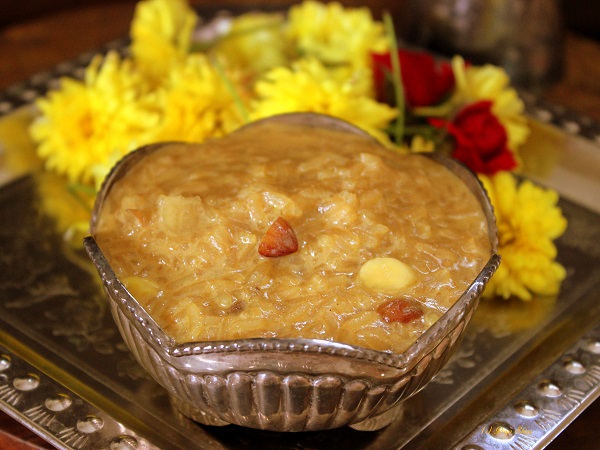 |
| Akkara Atisi (Sweet Pongal) |
 |
| Milk Atsil (Milk Rice) |
இட்டும் தொட்டும் கவ்வியும் துழந்தும்
நெய்யுடை அடிசில் மெய்பட விதிர்த்தும்
மயக்குறு மக்களை இல்லோர்க்குப்
பயக்குறை இல்லைத் தாம் வாழும் நாளே.
(Purananuru 188: 3-6 Poet: Pandian Arivudai Nampi)
He has not lived usefully in all his days, unless, he has fascinating children who can walk up to him in little steps, stretch out their tiny hands for food, set it down, touch and chew it, knead and smear rice and ghee all over themselves, interrupting his meals
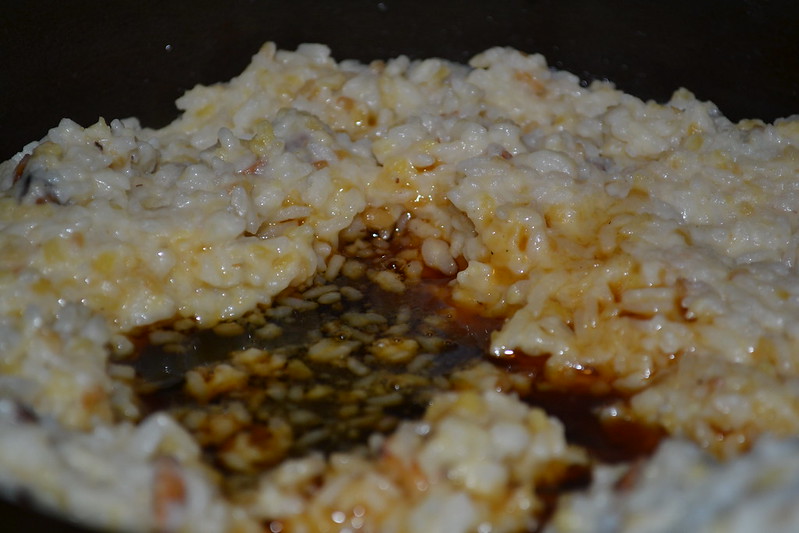 |
| Ghee Atisil (Ghee Rice) |
புதுக்கலத்தன்ன செவ்வாய்ச் சிற்றில்
புனையிரும் கதுப்பின் நின் மனையோள் அயரப்
பாலுடை அடிசில் தொடீஇய ஒருநாள்
மாவண் தோன்றல்! வந்தனை சென்மோ! – அகம் 394/9-12
(Akananuru 394: 2-6, Nanpalur Sirumethaviyar,)
Oh great generous lord, please come for a day to your small house with a front yard as red as a new clay pot, thorn fences and a pavilion with bent legs, where your wife with black, braided hair will serve you a meal with milk.
Raw rice cooked to glutinous consistency and being served with wooden ladle. The steaming rice dollop is now in the plate. The steaming spicy mutton gravy being poured on the rice scoop.
குய் குரல் மலிந்த கொழும் துவை அடிசில்
இரவலர்த் தடுத்த வாயில் புரவலர்
Purananuru 250: 1-2, Poet: Thayankanniyar
The sounds of cooking abundant rich food with spices used to stop those who came for alms at the door, preventing their leaving.
Poet Perunchithiranar sang to Kumanan. Kumamanan was the chieftain of Mutiram hills. The poet went to Kumanan and received abundant gift. The chieftain also served glutinous rice and the simmering broth with fatty meat and seasoned with ghee and spices. The spicy food prevents the bard from returning home.
குய் கொள் கொழும் துவை நெய்யுடை அடிசில்
மதி சேர் நாள்மீன் போல நவின்ற
சிறு பொன் நன் கலம் சுற்ற இரீஇ -
Purananuru 160: 7 - 9, Poet Perunchithiranar sang to Kumanan
Kumanan will place fatty meat cooked with spices and ghee on small gold bowls marked by constant use like stars that surround
the moon
Poet Avvaiyar sang on Athiyaman Neduman Anji. Athiyaman Neduman Anji was a Sangam Age chieftain who ruled Thakadur region. He was known for his valour and generosity. Poet Avvaiyar is in praise of the chieftain. The Chieftain served nectar like tasty food to the poet and the bards who visited the Chieftain's palace.
“அமிழ்தன மரபின் ஊன்துவை அடிசில்
வெள்ளி வெண் கலத்து ஊட்டல் அன்றி”
( Purananuru 390: 17 - 18, Poet Avvaiyar sang for Athiyaman Neduman Anji)He gave joy-giving toddy according to tradition and nectar-like tasty food with minced meat dishes in a white silver bowl.
In Pathitrupattu fifth ten poems 41 - 50 were composed by Poet Paranar sang on Kadal Pirakottiya Senguttuvan. In poem 45 the poet describes the hospitality extended by the Chera king. The king offered nectar like minced meat and rice in a silver bowl. -
“சோறு வேறு என்னா ஊன் துவை அடிசில்
ஓடா பீடர் உள் வழி இறுத்து”
(Patitrupattu 45: 13 - 14)
You dined in the company of your warriors, proud men who did not run away from battles, feeding them abundant meat and rice cooked together.
(Patitrupattu 45: 13 - 14)
You dined in the company of your warriors, proud men who did not run away from battles, feeding them abundant meat and rice cooked together.
2. Amalai (அமலை)
ஊன் சோற்று அமலை பாண் கடும்பு அருத்தும் - புறம் 33/14
Purananuru 33, Poet Kovur Kilar sang to Cholan Nalankilli, The families of bards are nourished with overabundant rice mixed with meat
அமலை கொழும் சோறு ஆர்ந்த பாணர்க்கு
Purananuru 34: 14, Poet Alathur Kilar sang to Cholan Kulamutrathu Thunjiya Killivalavan “May he live long, our king Valavan, who gives with an open mind abundant wealth to bards who utter sweet words and eat huge heap of rich, cooked rice mixed with honey and millet grown in dry fields, that are as large as the eggs of pigeons, with cooked rabbit meat.”
3. Ayini (அயினி)
Ayini means dining the unlimited amount of food.
துவரப் புலர்ந்து தூ மலர் கஞலித்
தகரம் நாறுந் தண் நறுங்கதுப்பின்
புது மண மகடூஉ அயினிய கடி நகர்ப்
பல் கோட்டு அடுப்பில் பால் உலை இரீஇ
(Akananuru 141: 12 -15. Poet Kapilar)
A small-bangled bride with fragrant 'thakaram' paste in her soft hair joins other women and boils milk on a stove with many sides.
4. Una (உணா) means cooked rice
பணை நிலைப் புரவி புல் உணாத் தெவிட்ட – Mathuraikanji 660
elephant keepers hand feed rice balls of food to their fierce male elephants in the stables,
சில் உணா தந்த சீறூர்ப் பெண்டிர் – Akananuru 283: 5
women from a small village bring food from the forest where they wander
5. Undi (உண்டி)
Undi (உண்டி) in general means food. Kuruntokai 156: 1-4 considers that those who consume undi (food) after observing fast from morning. Purananuru poem 18 states that those who gave undi (food) gave life. Undi means consuming undi (food) after observing fast or intake after feeling hungry.
கிணைமகள் அட்ட பாவற் புளிங்கூழ்
பொழுது மறுத்துண்ணும் உண்டியேன் அழிவு கொண்டு
(Akananuru 141: 12 -15. Poet Kapilar)
I will not leave him. I will not. I will not look at other faces. I, who eats food at improper times, ate the watery sour gruel given by a drummer woman who sold fish that she caught with a long pole.
 |
| Undi (உண்டி) Food Ready to eat |
உண்டி கொடுத்தோர் உயிர்கொடுத்தோரே
உண்டி முதற்றே உணவின் பிண்டம்
(Purananuru 18:19)
Those who give food give them life. Food is foremost to this body built of food.
(Poet Avvaiyar. Aphorism of Kondrai Vendhan)
Moderate eating makes a woman pretty
“மாறுபாடு இல்லாத உண்டி மறுத்துஉண்ணின்
ஊறுபாடு இல்லை உயிர்க்கு”
(Tirukural 945)
With self-denial take the well-selected meal; So shall thy frame no sudden sickness feel.
கிணைமகள் அட்ட பாகல் புளிங்கூழ்
பொழுதுமறுத்துண்ணும் உண்டியேன் (Purananuru 399:16,17)
cooked in a bright pot with fermented gruel, with vallai leaves from fields, fatty big pieces of horned fish, large pieces of varal fish,
Meaning: There will be no disaster to one's life if one eats with moderation, food that is not disagreeable.
6. Un or Oon (ஊண்)
Un or Oon (ஊண்) means food in general. Also cooked rice. It refers eating. Also the word means meat. (ஊன்).
Un or Oon (ஊண்) means food in general. Also cooked rice. It refers eating. Also the word means meat. (ஊன்).
தவச் சிறிதாயினும் மிகப் பலர் என்னான்
நீள் நெடும் பந்தர் ஊண் முறை ஊட்டும் (Purananuru 331:7,8)
Even though he has very little, he gives what he can, like a woman in a house who gives food under a pavilion in an orderly manner.
“ஊனும் ஊணும் முனையின் இனிதெனப்
பாலிற் பெய்தவும் பாகிற் கொண்டவும்
அளவுபு கலந்து மெல்லிது பருகி
விருந்துஉறுத்து ஆற்ற இருந்தனெ மாக”
(Puranānuru 381, Poet Puranthinai Nannakanar sang for Karumpanur Kilan)
When we were tired of eating meat (ஊன்) and food (ஊண்) along with sugar syrup mixed with rice in perfect proportions, enjoying his hospitality and having no hunger, we said to him, “Lord,we are leaving for our country with festivals!”
When we were tired of eating meat (ஊன்) and food (ஊண்) along with sugar syrup mixed with rice in perfect proportions, enjoying his hospitality and having no hunger, we said to him, “Lord,we are leaving for our country with festivals!”
7. Karunai (கருனை)
Karunai (கருனை) means food fried with either ghee or oil.
கருங்கண் கருனை செந்நெல் வெண்சோறு (Natrinai. 367: 3, Poet Nakkeerar)
Female crow calls its flocks to eat food offerings of fine white rice and karunai yam with black spots, that have been left for gods
Venison meat cut into chunks and fried and roasted with oil.
மண்டைய கண்ட மான் வறை கருனை
(Purananuru 398: 24, Poet Thiruthamanar sang for Cheraman Vanjan)
To me and my family, he gave venison to eat along with rice as long as a stork’s claw, the same food that he ate.
பசுங்கண் கருனை சூட்டொடு மாந்தி
Puranānuru 395: 37, Poet Mathurai Nakkeerar sang for Cholanattu Pidavur Kilarmakan Perunchathanthose who eat cooked fresh vegetables and meat along with boiled rice grains
பரல் வறை கருனை காடியின் மிதப்ப
(Porunaratruppadai 115 Poet Mudathamakkaniyar sang on Cholan KarikalanOne day, he gave me boiled rice that looked like jasmine buds, all the grains of same size, unbroken, with no streaks, and long like fingers, along with stir-fried dishes, resembling like gem stones.
8. Kali (களி)
Kali means paste like food prepared using flours of ragi (finger millet), tinai (fox-tail millet). It was a wholesome meal during Sangam era. It was enjoyed by people of strata. The millet flour is added slowly in a boiling water and stirred with a ladle to a paste like consistency.
 |
| Ragi Kali (ராகி களி) |
அவையா அரிசி அம் களி துழவை
(Perumpatruppadai 275 Poet Kadiyalur Urithirankannanar sang on Thondaimān Ilanthiraiyan)when you are hungry, you will receive freshly cooked fish and fine, fragrant liquor that is made by making a mash of unpounded, boiled rice spread on pots with wide mouths to cool,
அவையா அரிசி – unpounded rice (அவைத்த அரிசி - pounded rice), அம் களித் துழவை – beautiful boiled mash, துழவை (mash).
துடுப்பொடு சிவணிய களி கொள் வெண் சோறு - புறம் 328:11
Purananuru 328, Poet: Unknown,He will give you toddy, as sour as kalavu fruits, after he gives you dry pieces of meat cooked together with grains from plucked spears, and curds poured into a milk pot with ilanthai fruits, cooked with ghee, stirred with a ladle and served with white rice. துடுப்பொடு – with ladle, சிவணிய – stirred, களிக் கொள் – happily, வெண் சோறு – white rice
9. Sondri (சொன்றி) Cooked rice
Sangam era poems mean soru (சோறு) as cooked rice as well as the broth and the side dishes. Sondri (சொன்றி) is just the cooked rice or any millet. Sadham (சாதம்) (வடமொழி). Edible part of the paddy. (சொல்லுள் (நெல்லுள்) இருப்பது சோறு).
ஏற்றுக உலையே, ஆக்குக சோறே’
(Purananuru 172, Poet Vadama Vannakkan Thamōtharanar sang on Pittankotran)Set the pot on the stove! Cook the rice!
சுவல் விளை நெல்லின் செவ் அவிழ் சொன்றி
(Perumpanatruppadai 131, Poet Kadiyalur Urithirankannanar sang on Thondaimān Ilanthiraiyan)In every home, you will be given red cooked rice of paddy grown on high land.
சுவல் விளை – growing on the high land, நெல்லின் செவ் அவிழ்ச் சொன்றி – red cooked rice of paddy
குறுந்தாள் வரகின் குறள் அவிழ் சொன்றி
(Perumpanatruppadai 193, Poet Kadiyalur Urithirankannanar sang on Thondaimān Ilanthiraiyan)
You will receive a sweet tasting meal made with little millet (வரகரிசிச் சோறு) rice, looking like the large clusters of poolai flowers, cooked with white avarai beans.
புன்புல வரகின் சொன்றியொடு பெறூஉம்
Puranānūru 197, Poet Kōnattu Erichalur Madalan Mathurai KumaranarHe treats us well with cooked liitle millet (வரகரிசிச் சோறு) rice
புன்புல வரகின் – from the millet from dry fields, சொன்றியொடு பெறூஉம் – will get with the meal (millet),
10. Soru (சோறு)
Soru (சோறு) means cooked rice or millet which forms the main course or the whole meals.
எயிற்றியர் அட்ட இன் புளி வெம் சோறு - சிறு 175
(Sirupanatruppadai 175 Nallur Nathathanar. king Ōyman Nalliyakodan)Eyitriyar Women living in the waste land cooked hot rice mixed with sweet tamarind
வால் நிணம் உருக்கிய வாஅல் வெண் சோறு - அகம் 107/9
Akananuru107: 9, Kaviripoompattinathu Karikkannanar,White fatty meat melted with pure white rice
ஈயல் பெய்து அட்ட இன் புளி வெம் சோறு
Akananuru 394: 5, Nanpalur Sirumethuviyar,White ants (winged) from a wet mound (ஈயல்) were collected and cooked with white rice after pouring sweet tamarind.
கறி சோறு ஊண்டு வருந்து தொழில் அல்லது
(Purananuru 14, Poet Kapilar sang to Cheraman Selva Kadunko Valiyathan)
Since they know no stress, other than that of eating rice cooked with meat, and chunks of fresh meat roasted in fire with flower-fragrant smoke.
Since they know no stress, other than that of eating rice cooked with meat, and chunks of fresh meat roasted in fire with flower-fragrant smoke.
நிணம் பெருத்த கொழும் சோற்று இடை - புறம் 384/14
Purananuru 384: 14, Poet Purathinai Nannakanar sang to Karampanur Kilan,He pours ghee more freely than water on my rice with large pieces of fatty meat.
11. Thuzhavai (துழவை)
Semi-solid food (porridge) cooked using rice gruel or flours of millets. While cooking the porridge is well stirred with ladle. (துழாவியட்ட கூழ்). Its consistency is slightly looser than kali (களி).
 |
| Porridge well stirred with ladle. (துழாவியட்ட கூழ்) |
அவையா அரிசி அம் களி துழவை
(Perumpatruppadai 275 Poet Kadiyalur Urithirankannanar sang on Thondaimān Ilanthiraiyan)
when you are hungry, you will receive freshly cooked fish and fine, fragrant liquor that is made by making a mash of unpounded, boiled rice spread on pots with wide mouths to cool,
அவையா அரிசி – unpounded rice (அவைத்த அரிசி - pounded rice), அம் களித் துழவை – beautiful boiled mash, துழவை (mash).
12 நுவணை
Nuvaṇai means fineness. Flour obtained by hand pounding of rice and millets to fineness. (நன்கு இடித்த தனிய மாவு)
 |
| Honey and Foxtail millet (தேனும் தினை மாவும்) - நுண் இடி நுவணை |
மென்றிணை நுவணை யுண்டு
(Ainkurunuru 285, Poet Kapilar).
A mountain dweller’s daughter eats tender millet flour,
விசையம் கொழித்த பூழி அன்ன
உண்ணுநர்த் தடுத்த நுண் இடி நுவணை
Malaipadukadam 445, Poet Perunkundroor Perunkousikanar sang on King Nannan Venmān.
Every day you will be given dishes made with fine millet flour mixed with sifted sugar powder
விசையம் கொழித்த பூழி அன்ன – like sifted powder made with sugar, உண்ணுநர்த் தடுத்த – blocking others from eating (other food), நுண் இடி நுவணை – finely powdered millet powder
13. Valci (வல்சி)
Valci means particular food consumed by particular people or animal for their survival. Whatever may be the stuff or its status i.e., plant, corn, cereals, lentils, flesh, uncooked or cooked, beverages. For farmers rice, millets, lentils, fish, crab etc are the food (valci).
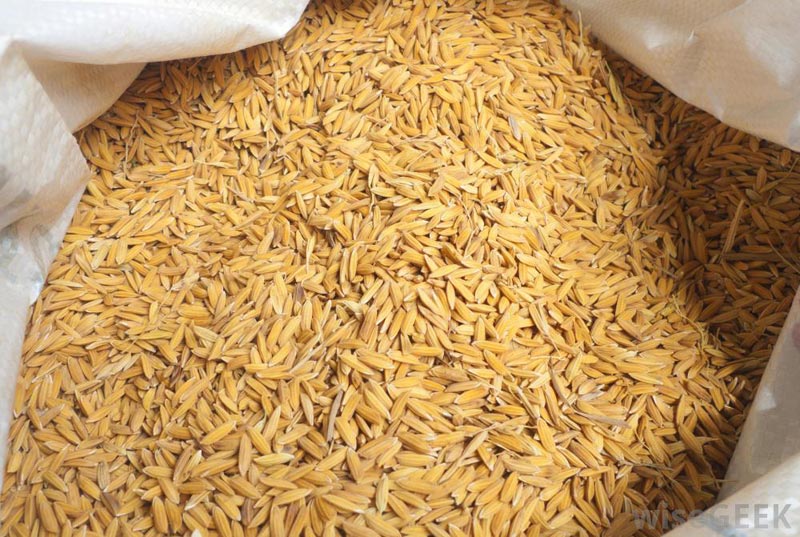 |
| Abundant food (குடிநிறை வல்சி) |
குடி நிறை வல்சி செம் சால் உழவர்
(Perumpanatruppadai 197)
Farmers (plowmen) are in possession of abundant food (vaci) where plowmen who create perfect furrows.
குடிநிறை வல்சி – abundant food in the community, செஞ்சால் – those who make perfect furrows to plant seeds, உழவர் – farmers, plowmen
.
வளம் செய் வினைஞர் வல்சி நல்க
(Malaipadukadam 462)
Women will serve you fish along with valci (cooked rice). Paddy produced by farmers of the land who cause prosperity.
வளம் செய் வினைஞர் – the workers who cause prosperity, வல்சி நல்க – give food
விளைபதச் சீறிடம் நோக்கி, வளைகதிர்
வல்சி கொண்டு, அளை மல்க வைக்கும்
எலிமுயன் றனைய ராகி,
(Purananuru 190, Cholan Nalluthiran,)
rats that look for the maturation season and collect
heavy clusters of grains and fill up their holes!
வினைஞர் தந்த வெண்ணெல் வல்சி
(Perumpanatruppadai 255)
you will receive food cooked with white (cooked) rice brought by workers .
 |
| Minced meat plus beans chutney mixed Rice (ஊன் துவை வல்சி) |
“செவ்வூன் தோன்றா வெண்துவை முதிரை
வால்ஊன் வல்சி”
Pathitruppathu 55 Poet Poet: Kakkai Padiniyar Nachellaiyar sang on Cheran Adukōt Pattu CheralathanYou are a body shield to your warriors
who eat white lentil chutney
and rice cooked with white meat
without any red meat.
Natrinai 6 Paranar
frolicking, delicate deer .eat ripe 'Kumilam' fruits with curved .tips that grow along the forest paths,
எறி மட மாற்கு – for the leaping innocent deer, வல்சி ஆகும் – will become food
Viands (பலகாரம்)
Kummayam (கும்மாயம்)
Kummayam (கும்மாயம்)
Sangam Tamils have enjoyed delicious viands (பலகாரம்) or tiffin. Perumpanarrupadai refers about 'Kummayam' (கும்மாயம்) prepared using lentils and jaggery.
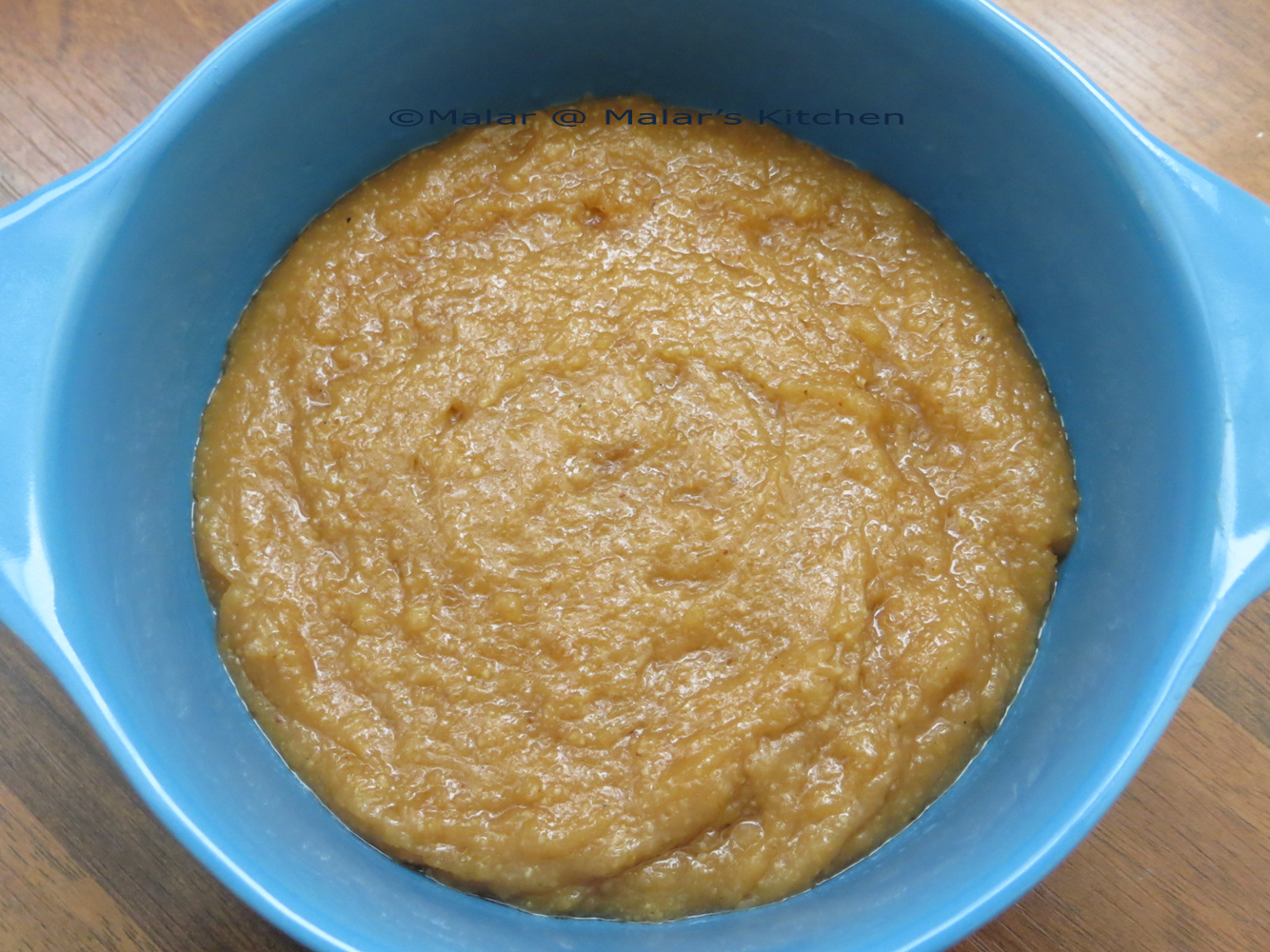 |
| Kummayam |
அவரை வான் புழுக்கு அட்டி பயில்வுற்று
இன்சுவை மூரல் பெறுகுவிர்
(Perumpanattruppadai 194 - 195)
You will receive a sweet tasting meal made with small millet, looking like the large clusters of poolai flowers, cooked with white avarai beans.
பயிற்றுத் தன்மை கெடாது கும்மாயமியற்றி
(Manimekalai)
Mel Adai (மெல் அடை)
In Mathuraikanchi there are information about vendors selling 'Mel Adai (மெல் அடை) sweet dish prepared with rice and it appears like a honey comb. It also refers about 'Mothakam' prepared with rice dough with sugar syrup fillings
நல்வரி இறாஅல் புரையும் மெல் அடை
அயிர் உருப்பு உற்ற ஆடு அமை விசயம்
கவவொடு பிடித்த வகை அமை மோதகம்
தீஞ்சேற்றுக் கூவியர் தூங்குவனர் உறங்க
(Mathuraikanchi 624 - 627)
vendors who sell delicate adais that are like honeycombs with fine lines and mothakams (மோதகம்) that are made on the palms pressing fingers, with fillings with sugar syrup, go to sleep,
Panniyam (பண்ணியம்)

Mathuraikanchi also refers about the vendors selling Panniyam (பண்ணியம்), a sweet dish appearing like present day Paniyaram.
பல்வேறு பண்ணியந் தழீஇத்திரி விலைஞர் (Mathuraikanchi 405)
காமர் உருவின் தாம் வேண்டு பண்ணியம் (Mathuraikanchi 422)சிறந்த தேஎத்து பண்ணியம் பகர்நரும் (Mathuraikanchi 506)
பல் வேறு பண்ணியம் கடை மெழுக்குறுப்ப (Mathuraikanchi 661)
Appam and idiyappam (ஆப்பம் இடியப்பம்)
Appam is another sweet dish mentioned in Silappadikaram and Manimekalai.
Appam is another sweet dish mentioned in Silappadikaram and Manimekalai.
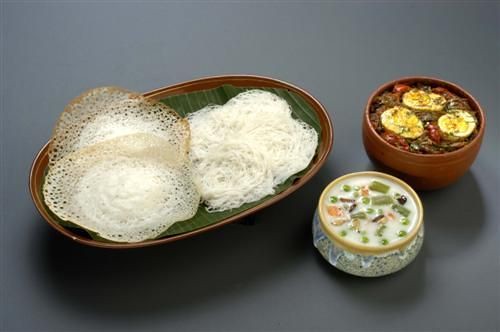 |
| Appam and Idiyappam with side dish |
According food historian K.T. Achaya, in his book 'The Story of our Food,' both appam (ஆப்பம்) (a circular pancake with a thick spongy center and lacy brown edges) and idiyappam (இடியாப்பம்) (steam cooked fine rice noodles) were already known in India around 1st century A.D. Both appam and idiyappam were the dishes sold by kaazhiyar and kuuviyar on the seashore. Sangam poems Perumpanatruppadai, Mathuraikanchi and Silappathikaram refer to the dishes. K. T. Achaya considers that dosai (தோசை) was already in use in ancient Tamil country around the 1st century AD, as per references in the Sangam literature.
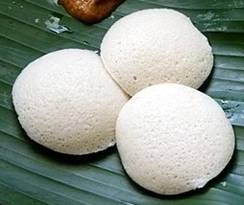 |
| Idly |
Idli (இட்லி)
Idli, a savory steam cake cooked using a batter consisting of fermented black lentils (de-husked) and rice, is the favorite dish through out South India and Sri Lanka. K.T. Achaya's theory is that idli is relatively a recent introduction to India, and it might have actually come from Indonesia. He notes that the word might derive from ‘iddalige’, first mentioned in Jain literary works in Kannada language - Vaddaradhane of Sivakotiacharya (920 AD) and Soopa Shastra of Mangarasa (1508 AD) But iddalige was made from urad dhal batter only, which was neither fermented, nor steamed to fluffiness.
Rice fry (பொரி) and Rice Flake (அவல்)
Idli, a savory steam cake cooked using a batter consisting of fermented black lentils (de-husked) and rice, is the favorite dish through out South India and Sri Lanka. K.T. Achaya's theory is that idli is relatively a recent introduction to India, and it might have actually come from Indonesia. He notes that the word might derive from ‘iddalige’, first mentioned in Jain literary works in Kannada language - Vaddaradhane of Sivakotiacharya (920 AD) and Soopa Shastra of Mangarasa (1508 AD) But iddalige was made from urad dhal batter only, which was neither fermented, nor steamed to fluffiness.
Rice fry (பொரி) and Rice Flake (அவல்)
 |
| Rice Fllakes |
Rice fry (பொரி) was in use during Sangam era. Sangam people cooked rice fry from boiled paddy. Ainkurunuru (ஐங் குறுநூறு) refers about a food prepared by mixing rice fry with milk (Ainkurunuru 53). Sangam literature also speak about rice flake (அவல்). Rice flake was produced by pounding the soaked boiled paddy. தீங்கரும்போ டவல் விருந்தோர் (Perumpanarruppadai). Akananuru poem 141 informs about pounding of rice flakes from bamboo rice (மூங்கில் நெல்).
பெருஞ் செய் நெல்லின் வாங்குகதிர் முறித்துப் பாசவல் இடிக்கும் பெருங் காழ் உலக்கை
Dairy Products (பால்பொருட்கள்)
Sangam Tamils have consumed more dairy products such as milk, curd, buttermilk, white butter, cheese etc.
Salt was considered as a precious commodity during Sangam period. Paddy and salt were equally priced 'நெல்லும் உப்பும் நேராகும்.' Salt was produced by 'Umanar' (உமணர்) community. Coconut was in use in Tamilakam since from 1st century A.D. Travelers note also mention about the coconut export to Rome.
Oven (அடுப்பு)
Oven (அடுப்பு) was used Sangam era people to cook food. They have used firewood as fuel. Sangam literature do mention about oven (அடுப்பு)
ஆடுநனிமறந்த கோடுயர் அடுப்பு
Puranānūru 164, Poet Perunthalai Sāthanar sang to Kumanan,
Mushroom has grown in our tall stove
பொருந்தாத் தெவ்வர் அரிந்தலை அடுப்பின்
Puranānūru 372: 5, Poet Mānkudi Kilar sang to Thalaiyālankanathu Cheruvendra Pandiyan Neduncheliyan
Enemies precious heads are severed and they appear like oven
பொருந்தாத் தெவ்வர் – not-agreeable enemies, அருந்தலை அடுப்பின் – precious heads as stoves,
உமண்சாத்து இறந்த ஒழிகல் அடுப்பில்
Akanānūru 119, Kudavāyil Keerathanar,
Warriors with strong bows cook meat on rock stoves abandoned by salt merchants
தீஇல் அடுப்பின் அரங்கம் போல
Akananuru 137: 11, Uraiyur Muthukoothanar,
your forehead has been ruined like the bare Kāviri islet (Arangam) without stoves and cooking fire
பல்கோட்டு அடுப்பில் பால்உலை இரீஇ (அக 141.15)
Akananuru 141, Nakkeerar,
A small-bangled bride with fragrant thakaram paste in her soft hair joins other women and boils milk on a stove with many sides.
உமண்உயிர்த்து இறந்த ஒழிகல் அடுப்பின்
Akananuru 159: 4, Poet Āmur Kavuthaman Sathevanar,
Salt merchants, who sell white, grainy salt, while resting in a camp lit the rock stove and abandoned while leaving from there
Attil (அட்டில்)
Mounting vessels on an oven is known as cooking ('அடுதல் '). Kitchen in Tamil is known as Attil (அட்டில்). or அடுக்களை Ref: தமிழர் உணவு, தொ. பரமசிவன்
புனிற்றுநாய் குரைக்கும் புல்லெ னட்டில்
Sirupanatruppadai 132 Nallur Nathathanar. sang on Oyman Nalliyakodan
In our kitchen, a female dog who had just given birth was barking in sorrow,
Cooking Pot (குழிசி)
Kuzhici means cooking pot or vessel.
இருங்கண் குழிசி கவிழ்ந்து இழுது மறப்பச்
Purananuru 65, Poet Kalathalaiyar
huge pots are placed upside down
மான் தடி புழுக்கிய புலவு நாறு குழிசி
Purananuru 168: 9, Poet Karuvur Kathapillai Sāthanar
They pour sweet elk milk with foam into an unwashed pot that smells of boiled deer
முரவு வாய் ஆடுறு குழிசி
Purananuru 371: 6, Poet: Kalladanar sang to Pandiyan Thalaiyalankanathu Cheruvendra Neduncheliyan
Carried the cooking pot with ruined mouth.
- Avvaiyars Kontrai Venthan nuggets in English. http://outshine-ga-ga.blogspot.in/2014/05/avvaiyars-kontrai-venthan-nuggets-in.html
- Beef Eating in the Ancient Tamizhagam. K. V. Ramakrishna Rao (A paper presented during the 57th session of Indian History Congress held at Madras from December 27-29, 1996). July 7, 2013. http://beef.sabhlokcity.com/2013/07/beef-eating-in-the-ancient-tamizhagam/
- Beef Politics: How Beef Was Consumed in Ancient Tamil Nadu. Ramanathan S. October 7, 2015 https://www.thequint.com/india/2015/10/07/beef-politics-how-beef-was-consumed-in-ancient-tamil-nadu
- Drinking habits in ancient India
- https://www.ncbi.nlm.nih.gov/pmc/articles/PMC4776591/
- Sangam Literature Wikipedia
- Sangam Literature – சான்றோர் செய்யுள் https://sangamtamilliterature.wordpress.com/sangam-tamil-books/
- இலக்கியமும் உணவுக் குறிப்புகளும் http://www.keetru.com/index.php?option=com_content&view=article&id=18907&Itemid=139
- உணவுப் பண்பாடு. அ.கா.பெருமாள். http://keetru.com/index.php?option=com_content&view=article&id=12554&Itemid=139
- உணவும் மதுவும் ப. சரவணன். http://www.tamilpaper.net/?p=8964
- கார்த்திகை விழாவிற்கு வருவார்! பெரியண்ணன் சந்திரசேகரன். டிசம்பர் 2005. தென்றல் http://www.tamilonline.com/thendral/article.aspx?aid=913
- சங்ககால சமையல் http://mazhimegam.blogspot.in/2014/01/1_30.html
- சங்கச்சோலை http://sangacholai.in/ and http://sangacholai.in/Essays-1.7.html
- சங்கத்தமிழரின் உணவுமரபு http://paniveli.blogspot.in/2014/10/blog-post.html
- தமிழ் மக்களின் உணவு புலால் http://www.vinavu.com/2015/06/25/flourishing-meating-culture-in-tamil-history/
- பண்டைய தமிழர் உணவுகள் http://vairamani-lakshmi.blogspot.in/2011/08/blog-post_8263.html
- பண்டைய கால தமிழர்களின் உணவு முறை! http://suvanappiriyan.blogspot.in/2014/08/blog-post_7.html
- திணை விளக்கம் Wikipedia
- தொல்காப்பியம் காட்டும் உணவு http://www.valaitamil.com/food-about-tolkappiyam_9017.html